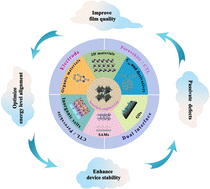Recent advances in the interfacial engineering of organic–inorganic hybrid perovskite solar cells: a materials perspective
Abstract
Research on perovskites, a highly promising type of semiconductor material in the field of photovoltaics, has made amazing progress. The development of perovskite solar cells (PSCs) has so far reached a certified power conversion efficiency (PCE) of 25.7%. Since the interfaces in PSCs are closely connected to the carrier dynamics (charge separation, transport, injection, collection and recombination), interfacial engineering has become a powerful tool in enhancing the device performance and long-term stability. This review focuses on critically discussing the emerging materials and strategies for interfacial engineering at the charge transport layer (CTL)/perovskite and CTL/electrode interfaces in PSCs with both normal and inverted structures. In particular, the underlying mechanisms of various materials for interfacial engineering in maximizing the PCE and the long-term stability of PSCs are systematically demonstrated. Finally, a brief summary of the latest advances and breakthroughs, and a perspective on the future research directions are presented, which are expected to promote the development of this important research field.

- This article is part of the themed collection: Journal of Materials Chemistry C Emerging Investigators


 Please wait while we load your content...
Please wait while we load your content...